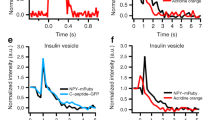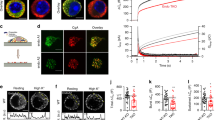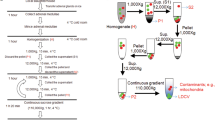Abstract
Recently, several groups1–4 have initiated studies on cytosolic proteins that bind to isolated secretory vesicle membranes in the presence of Ca2+ in order to identify proteins that may regulate exocytosis. Two major chromaffin granule binding proteins, of molecular weights 32,000 (32K) and 34,000 (34K), were reported to have the same mobilityon one-dimensional SDS gels as clathrin-associated light chains from the adrenal medulla, and the 34K granule binding protein the same one-dimensional peptide map as the 34K clathrin light chain5. These observations support the hypothesis that Ca2+ -dependent recruitment of soluble light chains to the vesicle membrane may nucleate the assembly of a clathrin coat and initiate endocytosis. Here we report that two-dimensional peptide maps of the clathrin light chains and of all chromaffin granule membrane binding proteins in the 30K range are distinct, and therefore fail to support this hypothesis. It has also been suggested that some or all of the vesicle binding proteins require calmodulin for their interaction with the membrane5. However, we find that antagonism of calmodulin by trifluoperazine does notprevent the association of the other cytosolic proteins with the chromaffin granule membrane.
This is a preview of subscription content, access via your institution
Access options
Subscribe to this journal
Receive 51 print issues and online access
$199.00 per year
only $3.90 per issue
Buy this article
- Purchase on Springer Link
- Instant access to full article PDF
Prices may be subject to local taxes which are calculated during checkout
Similar content being viewed by others
References
Creutz, C. E. Biochem. biophys. Res. Commun. 103, 1395–1400 (1981).
Creutz, C. E. et al. J. biol. Chem. 258, 14664–14674 (1983).
Geisow, M. J. & Burgoyne, R. D. J. Neurochem. 38, 1735–1741 (1982).
Brocklehurst, K. W. & Hutton, J. C. Biochem. J. 210, 533–539 (1983).
Geisow, M. J. & Burgoyne, R. D. Nature 301, 432–435 (1983).
Blaschko, H., Combine, R. S., Schneider, F. H., Silver, M. & Smith, A. D. Nature 215, 58–59 (1967).
Winkler, H. Phil. Trans. R. Soc. B261, 293–303 (1971).
Elder, J. H., Pickett, R. A., Hampton, J. & Lerner, R. A. J. biol. Chem. 252, 6510–6515 (1977).
Keen, J. H., Willingham, M. C. & Pastan, I. H. Cell 16, 303–312 (1979).
Creutz, C. E., Pazoles, C. J. & Pollard, H. B. J. biol. Chem. 253, 2858–2866 (1978).
Creutz, C. E. & Sterner, D. C. Biochem. biophys. Res. Commun. 114, 355–364 (1983).
Creutz, C. E. J. Cell Biol. 91, 247–256 (1981).
Brodsky, F. M., Holmes, N. J. & Parham, P. J. Cell Biol. 96, 911–914 (1983).
Laemmli, U. K. Nature 227, 680–685 (1970).
Author information
Authors and Affiliations
Rights and permissions
About this article
Cite this article
Creutz, C., Harrison, J. Clathrin light chains and secretory vesicle binding proteins are distinct. Nature 308, 208–210 (1984). https://doi.org/10.1038/308208a0
Received:
Accepted:
Issue Date:
DOI: https://doi.org/10.1038/308208a0
This article is cited by
-
Catestatin regulates vesicular quanta through modulation of cholinergic and peptidergic (PACAPergic) stimulation in PC12 cells
Cell and Tissue Research (2019)
-
Localization of clathrin light-chain sequences mediating heavy-chain binding and coated vesicle diversity
Nature (1987)
-
Clathrin light chains contain brain-specific insertion sequences and a region of homology with intermediate filaments
Nature (1987)
Comments
By submitting a comment you agree to abide by our Terms and Community Guidelines. If you find something abusive or that does not comply with our terms or guidelines please flag it as inappropriate.



